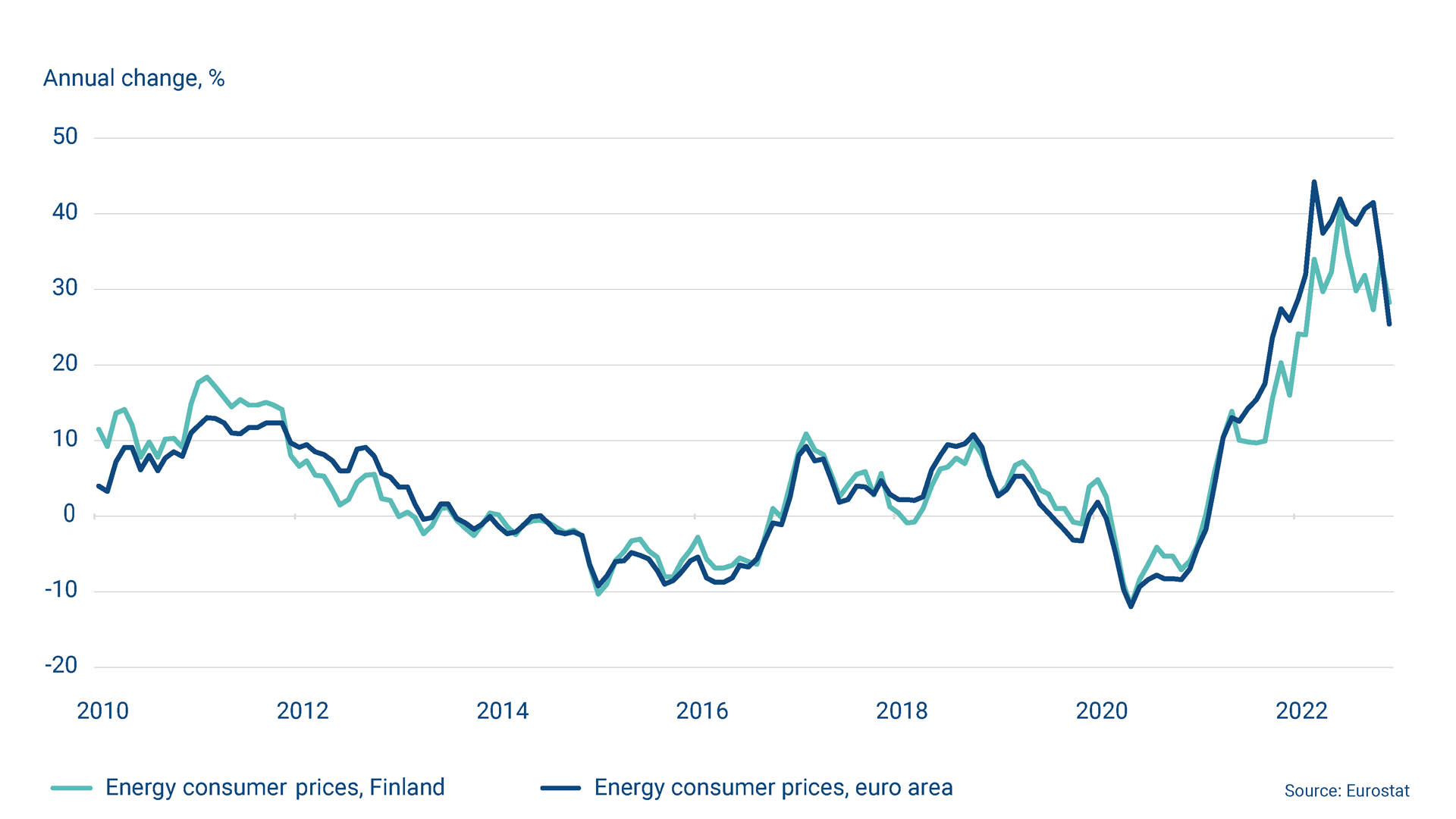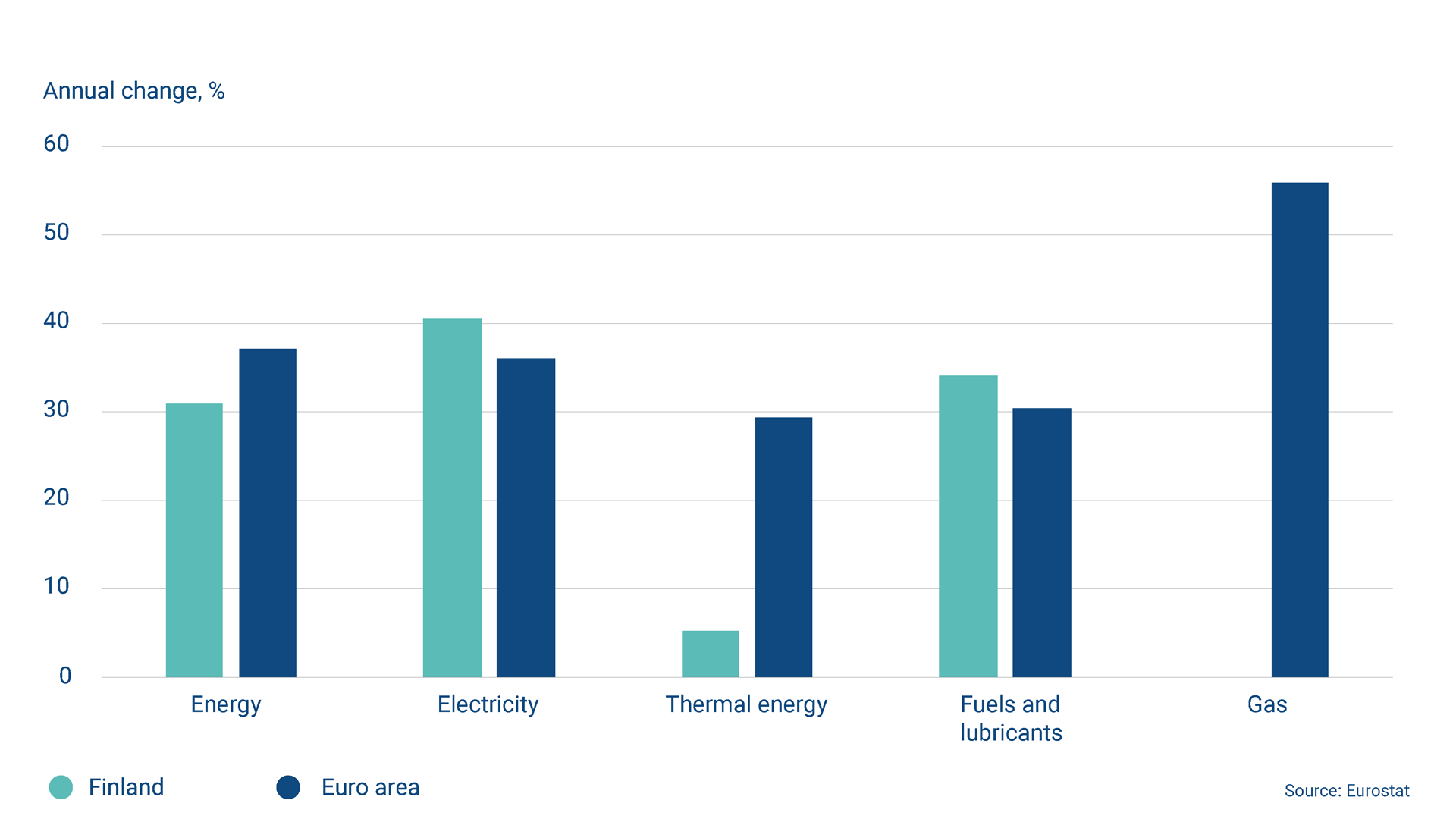In 2022, energy consumer prices in Finland increased by almost 31% but still more slowly than the euro area average. Electricity wholesale prices were the second lowest in the EU. According to Bank of Finland’s forecast, energy consumer prices in Finland will rise more slowly this year and will start declining in 2024.
Energy prices started to rise in the aftermath of the covid-19 pandemic in 2021 when the demand for energy began to recover and, at the same time, disruptions in supply restricted availability. The rise in prices continued during 2022 as a result of the energy crisis prompted by the Russian invasion of Ukraine. Higher raw material prices made energy significantly more expensive also for consumers in 2022, both in Finland and elsewhere in the euro area. However, following a downturn in energy raw material prices in late 2022, consumer prices are also expected to peak this year.
In direct terms, energy accounted for about 40% of Finland’s inflation rate in 2022. But the rise in energy prices also has indirect impacts on the prices of other commodities and if this is included in the estimations, energy would account for an even large share of the inflation. In Finland, energy consumer prices increased by almost 31% in 2022 (Figures 1 and 2). Fuel prices rose by more than 34% and electricity prices by just over 40%. At the same time, the price of thermal energy increased by only 6.2%.
Figure 1. In 2022, energy consumer prices in Finland rose more slowly than the euro area average.
In the long term, energy price trends in Finland have been similar to the euro area average, which primarily reflects fluctuations in raw material prices. However, in 2022, energy consumer prices in the euro area went up by 37%, which means that on average, the increase was more rapid than in Finland. The difference is mainly due to natural gas, which on average is widely used by households in the euro area but not in Finland.[1] Consumer prices of natural gas in the euro area rose by almost 56% last year. At the same time, consumer prices of such commodities as fuels and electricity increased at a slightly slower rate than in Finland. Termination of electricity imports from Russia in May 2022 boosted electricity prices in Finland. In the euro area, there was already a noticeable rise in electricity prices during 2021, whereas in Finland, due a different contract structure, wholesale prices were passed on to consumer prices more slowly. Despite the rise in electricity prices, electricity wholesale prices in Finland were the second lowest in the EU in 2022 (after Sweden).[2] When energy inflation comparisons are made, it should also be remembered that the compensatory measures introduced in Finland and in other European countries to soften the impacts of energy prices are shown in the HICP in different ways.[3]
Figure 2. Energy prices rose across the board in 2022.
What about the outlook for energy prices? According to the Bank of Finland’s December forecast,[4] energy consumer prices in Finland will rise more slowly this year and will start declining in 2024. As crude oil prices fall, fuel prices will start pushing the annual inflation rate downwards this spring. According to current market expectations, wholesale prices of crude oil, electricity and natural gas will fall from the high levels experienced last year. However, there is a great deal of uncertainty in these projections. On the one hand, the energy crisis may again come to a head, while on the other hand, higher than expected global demand could also lead to higher energy prices.
Electricity consumption fell sharply and generation of low-emission electricity increased substantially in Finland in 2022. This may bring positive long-term impacts for consumers and make Finnish industries more competitive as they have access to cleaner and cheaper energy.
Higher energy prices have adversely impacted consumer purchasing power and increased costs for businesses. The crisis has forced all parties to pay more attention to energy production, energy self-sufficiency and energy consumption. Electricity consumption fell sharply and generation of low-emission electricity increased substantially in Finland in 2022.[5] This may bring positive long-term impacts for consumers and make Finnish industries more competitive as they have access to cleaner and cheaper energy.
Sources:
[1] Natural gas (045200) has zero weight in the Finnish HICP consumption basket because few Finnish households use it. At the same time, natural gas is used to generate electricity and district heat in Finland.
[2] Finnish Energy, Energy Year 2022-Electricity.
[3] Eurostat: Treatment of energy price compensation schemes in the HICP.
[4] https://www.bofbulletin.fi/en/2022/4/finnish-economy-set-to-slide-into-recession/.
[5 Finnish Energy, Energy Year 2022-Electricity.



